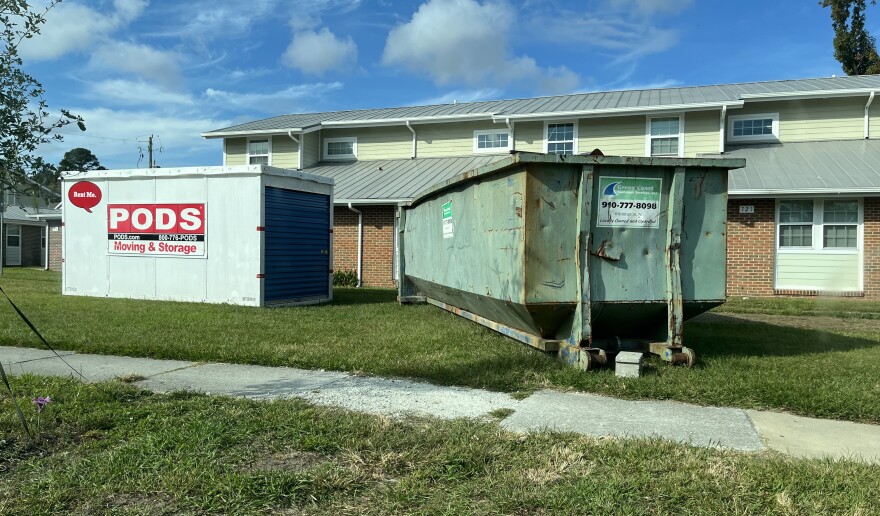In mid-November, Wilmington Mayor Bill Saffo wrote the Wilmington Housing Authority to demand "immediate action" and a full accounting of the mold crisis, complete with a plan to return everyone of the displaced families to their homes.
At the time, there were about 80 displaced families, and WHA was estimating costs of around $100,000 per month. Saffo asked for WHA's answer by December 1, but later granted the authority an extension.
Last week, WHA delivered its response to the Mayor in a letter signed by WHA Board of Commissioners Chair Al Sharp. It details a list of proactive steps WHA is taking or plans to take — but it also shows the further deterioration of the situation and just how long it could take to get residents home.
The bad news
The human cost of the mold crisis has increased. There are currently 111 families displaced — including from the hardest hit neighborhoods: 47 from Creekwood, 19 from Woodbridge, 19 from Houston Moore, and 12 from Hillcrest.
The letter also includes a more accurate estimate of the costs that is significantly higher than what WHA discussed in November, when the WHQR first investigated the crisis. At the time, Sharp and interim CEO Vernice Hamilton, who took over when former CEO Katrina Redmon resigned in the midst of the disaster, discussed the main costs: mold remediation through WHA's sole-source contractor and housing displaced families, which included hotel costs and per-diem.

What Sharp and Hamilton did not discuss was the 'rehab' — the work necessary to bring an apartment back up to code and livable standards after mold was remediated. Those costs are considerably higher, making up almost 60% of the overall cost estimate.
Based on the more complete picture of the situation given to Mayor Saffo by WHA this month — the estimated cost of tackling 111 units at an average cost of $77,297 per unit would be $8.5 million. (WHA's report to Saffo doesn't explicitly list $8.5 million as a cost, and WHQR has reached out to WHA to confirm this number.)
In Saffo's November letter, he asked WHA for a 'forecast' of when every displaced resident could be returned home or to another remediated unit. WHA's answer is not a happy one.
"As much as we would hope to forecast a date in the interests of the residents, the community and WHA, a year would be a hopeful guess," Sharp wrote to Saffo.
WHA cites the "enormous challenge" of finding hotels, as well as problems created by hotel policies that simply aren't geared towards long-term, large family stays. Families who have spoken to WHQR frequently mention bans on cooking in rooms, having guests, allowing children to play outside or in the hallways, and requiring an adult in each room, which makes it difficult for single parents, usually mothers, to stay with multiple children.
WHA also notes that no market-rate apartments have agreed to lease to displaced families beyond the nine currently being used by WHA, although the authority says "we have early indication that the situation may improve early next year."
Steps being taking by WHA
WHA reports it is taking a number of steps, including moving away from tenant-based reporting of mold issues to a inspections of all units on a rolling basis, along with more general quarterly inspections.
WHA also says it's working to acquire more contractors for the rehab portion of fixing up units — the most expensive part of the process. Currently, WHA says it has 16 invitations for quotations (IFQs) pending (note, there are currentlyno IFQs posted on WHA's website page).
WHA says it is also reaching out to construction and development communities for help. WHA also plans to hire a new project manager for all construction — and create a new position to handle centralized communication for mold-related issues. WHA also plans to provide a variety of mold prevention and other upkeep training for residents.
An even more important hire could be a new CEO to replace Katrina Redmon, who left abruptly and without substantive reasons right as WHA's Board of Commissioners was becoming aware of how bad the crisis had become under her management. According to WHA, it is "involved with an Executive Search firm for a new CEO" and other top management roles, including two top positions that Redmon laid off as the mold situation was hitting the crisis stage this summer.

Help from Wilmington, New Hanover County
In his letter to Mayor Saffo, Sharp thanks the City of Wilmington for its support. Help has also come from the county in the form of ongoing counseling for displaced residents.
According to the county, "Health and Human Services coordinated mental health sessions with displaced WHA families, utilizing our mental health supervisors and several of our therapists."
For Sonya Muldrow, a displaced resident from Creekwood, the session was a lifeline.
"It was a relief — to talk to someone about your mental health and the abrupt change in your life. It was like an exhale. It gave you some clarity, some peace of mind. For me, it gave me a lot of hope, you know, like I can endure this," Muldrow said.
Muldrow said she thought the counseling sessions were especially important for children who have been living in hotel rooms, some for months.
"It went well, and especially for the children — because I heard a lot of parents talking about how their children's grade have dropped severely while they've been displaced...it was terrific for the kids," she said.
Still, many of the kids are now facing another holiday living in hotel rooms and it remains unclear when, exactly, their displacement will end.
Below: The Wilmington Housing Authority's response to Mayor Saffo, delivered December 15, 2021.
December 15 2021 WHA Letter to Bill Saffo by Ben Schachtman on Scribd



